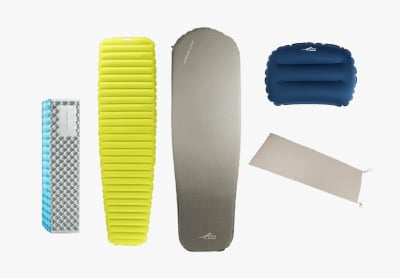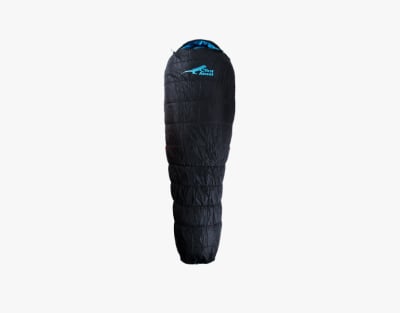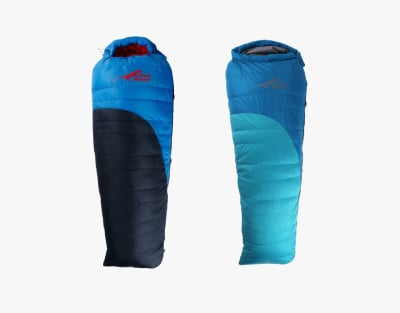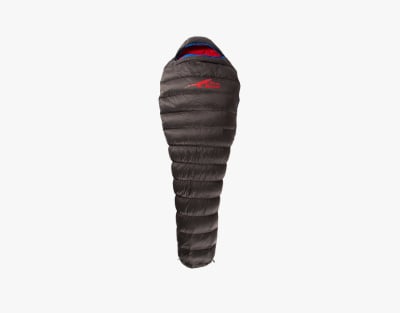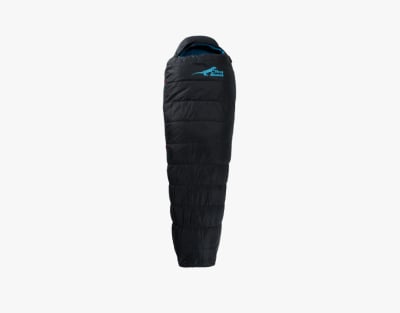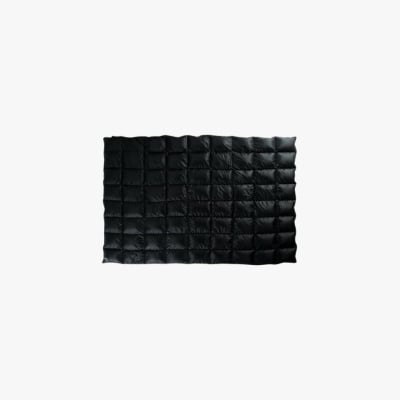For outdoor enthusiasts, a multiday hike is the perfect way to escape your desks and screens and experience the beauty nature has to offer. Besides gorgeous views, fresh air, and a sense of accomplishment and adventure, the feeling of cosying up in your sleeping bag after a long day of hiking is a highlight - provided you have the right one.
The human body is designed to maintain a constant core temperature of approximately 37°C. To maintain this temperature, you need to provide yourself with proper insulation. A sleeping bag if sleeping outdoors, whether that’s under the stars or in a tent or cabin, is essential not only for your comfort but also for your safety. If you get trapped in extreme weather, your sleeping bag is your guard against hypothermia and other adverse effects.
Choosing the correct sleeping bag for your adventure can be quite a daunting task with temperature ratings, fill type, shape and weight to consider - you need to strike a balance between weight, warmth and cost.
First Ascent has been making sleeping bags for over three decades- that’s actually how we got our start, stuffing sleeping bags in a garage in 1989. Our down sleeping bags are still hand-stuffed locally in the heart of Cape Town. We know a thing or two - so read on so you can make the most informed choice.
Where are you going?
Weather can be incredibly unpredictable - especially in South Africa. One moment we have sunshine, the next clouds, rain and high winds. Besides weather changes, usual day/night temperature fluctuations can swing wildly from a hot sunny day to a frigid below-zero night, even in summer. It is therefore critical to understand the environment in which you will be sleeping and the expected weather forecast.
TOP TIP: Store your sleeping bag in a dry bag in your pack so it doesn’t get wet in rainy conditions or during river crossings.
How long are you going for?
Seasoned adventurers understand how important it is not to carry too much weight and have to make compromises on what to take vs what to leave. One item you should never compromise on is the sleeping bag you take with you. The last thing you need is to have your trip ruined by poor sleep by either being too cold (insufficient sleeping bag insulation) or too uncomfortable while trekking (sleeping bag is unnecessarily heavy). Just remember that the warmer the sleeping bag - the more filling it has, making it heavier.
Down or synthetic?
Waking up shivering in your tent at night does not make for a happy hiker. Ensuring your sleeping bag has the right insulation is crucial, and shouldn’t be compromised. The two primary types of insulation, down and synthetic, each have their pros and cons.
Down: Down insulation offers exceptional warmth-to-weight ratio and compressibility. It's ideal for cold and dry conditions. It performs poorly when wet.
Synthetic: Synthetic insulation retains its insulating properties even when wet, making it suitable for damp and humid environments. While synthetic bags may be heavier and less compressible than down bags, they are often more affordable and easier to maintain.
What is a temperature rating?
Each of our sleeping bags has a specific temperature rating that is determined primarily by the sleeping bag filling (down or synthetic).
Sleeping bags are typically assigned temperature ratings to indicate the lowest temperature at which they will keep you warm. These ratings help you match the bag to the expected weather conditions during your hike.
For multi-day hiking in different seasons and climates, it's essential to pick a sleeping bag with a temperature rating that matches the coldest conditions you anticipate facing. Keep in mind that personal factors such as metabolism and clothing layers can also impact your comfort level, so it's often advisable to choose a bag rated a bit lower than the expected temperature to cover your bases.

Comfort: Based on a person having a comfortable night's sleep.
Lower Limit: Based on a person as the lowest temperature to have a comfortable night's sleep.
Extreme: The minimum temperature at which a person can remain for six hours without the risk of death from hypothermia (though frostbite is still possible).
Ratings are based on an averagely-sized user wearing one long thermal underwear layer and a beanie, and sleeping on a foam pad. Ideally, using a foam pad and mattress can ensure insulation is warm enough from the ground. You’ll also want to take into consideration factors such as how comfortable you are in certain temperatures, whether you’ve eaten that day, your sex, your metabolism, your sleeping pad, what layers you’re wearing etc.
Other considerations:
Shape
Sleeping bags come mainly in three shapes: rectangular, semi-rectangular and mummy. Your choice of shape is usually a weigh-up between roominess and efficiency.
Rectangular and semi-rectangular: These shapes offer more space making it easier to roll over in the night. However, that extra space also means more air pockets, so it’s not as warm.
Mummy: A mummy-shaped bag is wilder at the top and more narrower at the feet, ensuring a snugger fit, and trapping heat. Some people find it more constricting, but it keeps body heat better.
Ensure the sleeping bag you choose provides enough space to sleep comfortably without being excessively large, as extra space can create cold spots. Many manufacturers offer sleeping bags in different sizes to cater to various body shapes and heights.
Additional Features
Multiple small features make a difference in your sleeping bag:
- Grip pads stop you from sliding around on your mattress
- Little pockets are great for your earplugs or valuables that you want to keep close to you.
- A cowl or hood adds extra warmth by trapping heat
- Draft collars and draft tubes prevent warm air from seeping through the zipper
- Extra zipper placements on the side and bottom allow for extra ventilation, or connecting multiple bags. Many bags also offer you the choice of a zipper on the left or right side to suit you.
Keep in mind any additional features may add extra weight, so consider what’s most important to you.
Accessories
No sleeping system is complete without somewhere soft to lay your head. You can stuff clothes into your sleeping bag to make a pillow. For a better set-up, a lightweight hiker pillow will add that extra bit of comfort so you can tackle the day fresh.
A foam pad and mattress increase insulation by keeping you off the ground and is an absolute essential.
If you find yourself with a sleeping bag that might just not cut it for expected temperatures - and you want to be extra prepared - the Thermolite Sleeping Bag Heating Liner can lower the temperature rating of your bag by adding 5⁰C to 15⁰C of extra warmth.
Our top picks:
Summer/Spring: Amplify 900 Synthetic
Remember, even some South African summer nights can get chilly depending on where you are. The Amplify 900 Synthetic sleeping bag covers a nice range, with a comfort rating of 7⁰C. Synthetic fill means it can easily withstand those summer showers, whilst still being lightweight enough to take with you on your next adventure.
Winter: Icebreaker or Ice Nino
Whether you are sleeping on top of a mountain range in Drakensberg, or backpacking through the Tankwa during the colder seasons, the Ice Breaker is the best choice for all-round cold weather use, with a comfort rating of -3⁰C. The Ice Nino is the smaller version of the Ice Breaker, designed for smaller framed people.
Lightest: Amplify Down Light
A summer adventure that allows you to sleep under the stars and take in the night sky calls for a comfortable companion. The Amplify Down Light Sleeping bag is exceptionally lightweight at only 595g, but will still keep you warm. With a comfort rating of 9⁰C, you’ll stay cool but cosy under the evening sky.
Multipurpose: Amplify 1500 Synthetic
Often we need a sleeping bag for more than one type of adventure or occasion. The Amplify 1500 Synthetic Sleeping Bag with a comfort rating of 5⁰C is ideal for almost all seasons. Elastic stitching makes this sleeping bag particularly comfortable. Benefits include minimized heat loss, as well as easy mobility when needed. Synthetic fill also has the added advantage of being easier to clean and quicker drying than down.
Compact Down Blanket
While it may not be a sleeping bag, the Compact Down Blanket provides superior warmth and follows the principles of ultra-lightweight hiking. Ideal for when a sleeping bag is not preferred, hutted hikes where a sleeping bag is not required or even as a campfire companion. The Down Blanket is extremely compact, packing up into its internal stuff bag for easy storage.
Choosing the right sleeping bag - considering weight, temperature, shape, size and additional features - is essential for a comfortable and rejuvenating night’s rest on the trail. With all this in mind, hopefully, you have a good blueprint for choosing the right sleeping bag for you and your next adventure. Wishing you many nights of blissful sleep under the stars as you explore the wonders of the great outdoors!
Read our Down and Synthetic Sleeping Bag Guides
Find a tent to match with this blog on choosing the right tent, or our tent guide
Shop a full sleeping system here or read more about sleeping systems
View our Monthly Kit Lists.
Not sure where to go on your next hike? Find your next trail.

